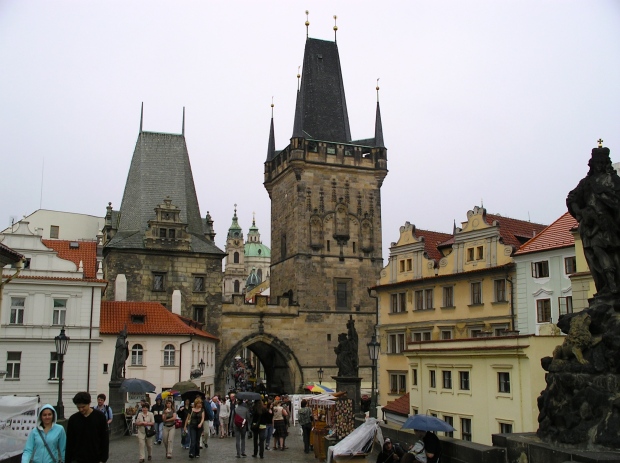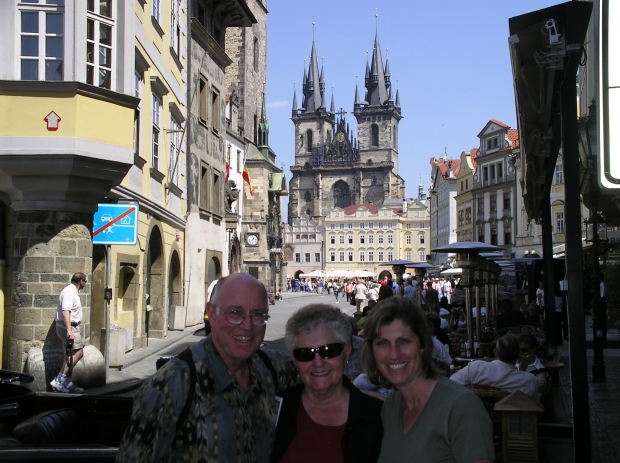Prague, in the Czech Republic, is a beautiful city with striking architecture and an interesting history. It is a city that lends itself to walking. The Vltava River (the same river that runs through Český Krumlov) divides the two main tourist hubs, Old Town Square and Prague Castle hill.
Here are just a few highlights of Prague along with two castles outside the city.
Prague Castle
As castles go, it’s a little hard to recognize Prague Castle as such from the exterior – it just looks like a collection of buildings, and yet there is a lot to do here – palaces, museums, churches and shops. The castle area surrounds a large square which includes St. Vitus Cathedral. The cathedral is so massive and “shoehorned” into such a small area, it is difficult to get a good close-up photo of this stunning structure.

A view of St. Vitus Cathedral (begun in 1344 and finished 600 years later), along with various buildings of Prague Castle.

Basilica of St. George and Convent. This red building is Prague’s best-preserved Romanesque church. It dates from the 900’s. The convent to the left houses an art museum. These buildings are part of the Castle Square.
Golden Lane. This is an old medieval street just below the castle grounds.

Golden Lane. Little shops in old medieval houses. A quaint little area in Prague’s Castle Quarter.
Charles Bridge
This bridge was built in the 14th century by King Charles IV and was the only bridge in Prague to cross the Vltava river until 1850.

On the Charles Bridge, with lots of tourists moving between the Old Town Square and Prague Castle. Artists and various vendors line the bridge along with statues. The tower (on the east end, near Old Town Square) was originally a toll booth.

The Castle (west) end of the Charles Bridge.
Old Town Square
Located on the east side of the Vltava river, this square dates from the 11th century. It was once the center for executions of convicts. A lane, called “The King’s Walk” connects Old Town Square to the famous (and busy) Charles Bridge which then leads to Prague Castle.

A view of Týn Church and Old Town Square.
The Gothic Týn Church is a major landmark of the Square and has been the main church in this part of Prague since the 14th century. Nearby is the 15th century Old Town Hall and astronomical clock, which is quite fascinating–it tells time in a variety of ways (with Roman numerals, Gothic numbers and planetary symbols).

The 15th century astronomical clock on the Old Town Hall. It was damaged in World War II and largely reconstructed.

Another view of Old Town Square and Týn Church (the astronomical clock and Old Town Hall are just to the left of the church).

A street scene in Old Town Prague.
Jewish Quarter
Close to the Vltava River, the Jewish Quarter contains several synagogues and a Ceremonial Hall which can be visited. In addition, there is an old Jewish cemetery (which was the only burial ground in Prague allowed for Jews for 300 years). Centuries ago, the Jews were required to live separately from Christians. Of the 120,000 Jews living in this area in 1939, only 10,000 survived to see liberation from the Nazis in 1945.

Old-New Synagogue. Built in 1270, it’s the oldest synagogue in central Europe.
Nearby Castles – Karlštejn and Konopiště
Twenty miles southwest of Prague is Karlštejn Castle, one of the Czech Republic’s great attractions. It is a bit of a hike up to the castle from the car park, but the route has lots of little shopping booths to keep you entertained along the way.

Karlštejn Castle. Built in 1350 to house the crown jewels of the Holy Roman Empire. Reservations are required to see the Chapel of the Holy Cross where the crown jewels were housed.
Konopiště Castle. This castle is 30 miles south of Prague. There is an interesting (and free) display of numerous statues of St. George “slaying the dragon” here.

Konopiště Castle. Construction began in the 14th century, but the castle was largely modernized around 1900 by Franz Ferdinand, heir to the Hapsburg throne. The castle houses an excellent medieval arms collection.













